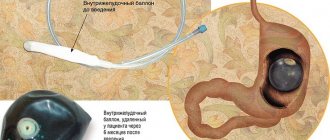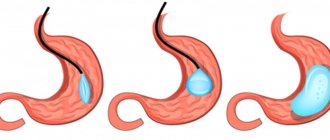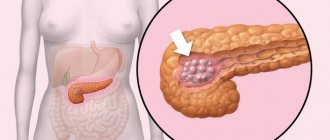28.06.2017
Diseases of the chest and abdominal cavity | Gastrointestinal tract
Health is harmony. Disease is its violation. Let's apply this ancient thesis to the problem of obesity.
Do we need adipose tissue? Certainly! Otherwise it wouldn't exist at all. And not only in people, but also in other living beings. Why is it needed?
First of all, to protect internal organs:
- mechanical;
- thermal (insulation and energy source);
- antitoxic (toxins that the body cannot get rid of are “hidden” out of sight - in the fatty tissue of the buttocks and thighs);
- energy (fat is a reliable source of energy that is available to the body during so-called lipolysis).
Adipose tissue stores not only toxins, but also what the body may still need - water, hormones, etc. And not only stores, but also creates! The same hormones, for example. Sex hormones have been known for a long time. But they learned about adiponectin only at the end of the twentieth century. It is an active participant in carbohydrate-fat metabolism, and it precisely maintains the “metabolic harmony” of the body (preventing the occurrence of obesity, diabetes, inflammation in tissues, and atherosclerosis). The paradox is that the more adipose tissue, the less it produces this hormone.
The first stages of the formation of vitamin D (without it the body is unable to absorb calcium) are also carried out by adipose tissue.
And adipose tissue also serves as a source of stem cells! These “jacks of all trades” can carry out a variety of rescue operations in the body and turn into cells of bone, cartilage, muscle, nervous and other tissues.
But if fat is so good, why is too much of it bad?
First of all, the mass. Although fat is light, but in large quantities it gives a noticeable weight gain. An additional “backpack” also loads the body’s systems, just like a real one. Only rarely does anyone actually periodically walk with a backpack of 30 or even more kilograms. Particular overloads occur on the cardiovascular system (the heart itself, arteries, veins), respiratory, excretory and endocrine. Although adipose tissue produces important biologically active substances, it is not always “more fat - more substances”, and “more substances - better for the body”.
Disharmony of fat metabolism is both the cause and component of the so-called. metabolic syndrome - disharmony at the level of the whole organism. Its tangible manifestations, entailing other ailments (diabetes mellitus, atherosclerosis, ischemic heart disease, sleep apnea, stroke, etc.), are: insulin resistance, arterial hypertension, endocrine disorders, etc.
Causes of obesity of alimentary-constitutional origin
In the birth of obesity, two components play a special role: a person has no control over the first, the second, especially in the first stages, is entirely in his hands. The first - constitutional - is a genetic given (here is not only the risk of developing metabolic disorders, but also the likelihood of excessive appetite and an inhibited satiety reaction). But conditions are needed for potency to enter the active phase. They are created by the second component - nutritional. Its essence follows from the name. We are talking about nutrition (“alimentum” translated from Latin means “food”) in the sense of both the quantity and quality of what is eaten. But that's not all. Another factor is the body's need for energy and nutrients. The more active your lifestyle, the higher it is.
As a result, we obtain a simple exchange formula: receipt minus expenditure. The higher the final value, the more worries the body has about what to do with the excess. Against the background of the corresponding genetic data, the body chooses a completely logical method - to save in reserve. Moreover, in difficult living conditions (in the past, and for some in the present), such a strategy was one of the conditions for survival.
One should not discount the factor of upbringing, or rather, the habits adopted in the family.
In psychosomatics, the topic of obesity is associated with the concepts of “protection” and “love”. Only a person acquires them at the wrong level. The same principle applies to increased appetite. Unsatisfied spiritual hunger (its “food” is conscious life experience) “descends” to the level of the body and finds its satisfaction in the absorption of material food.
Causes of first degree obesity
The basis of obesity of the first degree is, as a rule, a decrease in physical activity while maintaining the same diet. A person is accustomed to certain food; it satiates him. At the same time, for some reason, he began to move less or the speed of metabolic processes decreased. Nutrients (nutrients) are supplied as before, but their consumption has decreased. In this case, the excess begins to be deposited in the body as fat.
It is imperative to look for the reason why the process of fat deposition started. For grade 1 obesity, these may be:
- overeating (nutritional, that is, food obesity);
- disorders of the hormonal system (Cushing's syndrome, Hashimoto's disease, diseases of the thyroid gland, hypothalamic-pituitary system, disruption of the pancreas and the absorption/production of insulin, etc.);
- genetic predisposition;
- disorders and diseases of the digestive system;
- PCOS is polycystic ovary syndrome, a common cause and at the same time a concomitant disease that provokes grade 1 obesity in women;
- taking certain medications (eg, contraceptives, systemic glucocorticoids);
- psychogenic, compulsive overeating;
- stress, lack of sleep, excessive sleepiness.
Symptoms of nutritional-constitutional obesity
Doctors have their own markers that help determine the degree of distress: body mass index, the thickness of the fat fold under the shoulder blade, on the thigh, abdomen, etc. But you can do without them: obesity in the literal sense of the word is obvious.
Other signs are already a consequence of stress, and over time, overload of the body's systems. This:
- dyspnea;
- high blood pressure;
- sweating;
- problems with the digestive system;
- joint pain;
- venous insufficiency;
- sleep disorders;
- fast fatiguability;
- apathy.
And... a strong feeling of hunger. This paradox is explained both by changes in metabolism during obesity (huge reserves become truly untouchable and are instantly replenished by blood glucose, the decrease of which causes hunger), as well as by disturbances in appetite regulation and a lack of satiety.
Obesity in men. How to help a patient: practical advice
12.01.2020
2788
0
| E.Yu. Gritskevich , endocrinologist, andrologist (Moscow) |
During the urological Internet conference No. 6, endocrinologist, andrologist and weight loss specialist Elena Yurievna Gritskevich made a report on possible approaches to solving the problem of obesity.
According to the WHO definition, obesity is a chronic disease, heterogeneous in etiology and clinical manifestations, progressive in its natural course, characterized by excessive deposition of fat mass in the body and a relapsing nature
What is more accurate: BMI or waist circumference?
A tool for assessing the presence and severity of obesity is the body mass index (BMI) - the ratio of body weight in kilograms to the square of height in meters (kg/m2). According to WHO, a diagnosis of overweight or obesity is made in adults in the following cases:
- BMI greater than or equal to 25 – overweight;
- BMI greater than or equal to 30 – obesity;
- Waist circumference more than 94 cm.
However, it should be remembered that even with a BMI above normal, a patient can have a large percentage of muscle mass, and therefore not suffer from obesity. In some cases, focusing on waist circumference may be more reasonable.
If previously men lagged behind women in the prevalence of obesity, today its prevalence rates are almost equal between the sexes.
Patient examination algorithm
Individually, according to indications, a number of laboratory examination methods can be used in obese patients:
- performing a glucose tolerance test;
- lipid profile (total cholesterol, triglycerides, HDL, LDL);
- liver function indicators (bilirubin and its fractions, ALT, AST, alkaline phosphatase);
- determination of thyroid function (TSH, sT4);
- overnight dexamethasone test with one mg of dexamethasone if endogenous hypercortisolism is suspected;
- testosterone, prolactin, FSH, LH, estradiol, SHBG;
- C-peptide and insulin for suspected hyperinsulinemia (eg, insulinoma, nesidoblastosis, etc.).
Among the instrumental examination methods that can be used are:
- bioimpedansometry;
- Ultrasound of the abdominal organs and kidneys;
- Ultrasound of the thyroid gland;
- Ultrasound of the pelvic organs (scrotum);
- ECG;
- ECHO-KG;
- 24-hour blood pressure monitoring, ECG monitoring;
- radiography of the skull, sella turcica;
- polysomnography;
- MRI of the pituitary gland with contrast enhancement;
- MRI of the brain.
Which diet is better?
The basic principles of weight loss are a balanced diet, physical activity, normalization of carbohydrate, lipid and other types of metabolism if they are disturbed, if necessary, drug therapy, and in case of morbid obesity, bariatric surgery.
The most appropriate diet therapy for weight loss should be safe, effective and something that the patient can adhere to. Meals should include all major food groups. It is recommended to monitor the food eaten in the form of a food diary, which also records daily physical activity. Individual food preferences, eating behaviors and eating patterns must be taken into account, as well as cultural background, food traditions and availability, timing and financial concerns, food knowledge and culinary skills.
Low-calorie, fat-restricted diets lead to greater reductions in total and LDL cholesterol, while carbohydrate-restricted diets lead to greater reductions in serum triglycerides and increases in HDL cholesterol, as well as greater reductions in serum glucose HbA1c.
Separately, Elena Yuryevna mentioned the “Mediterranean” diet, which is not a specific diet, but rather a generalized term for several food options that are often found in Greece, Italy and Spain. The Mediterranean diet has the most consistent and robust scientific support for reducing the risk of atherosclerotic cardiovascular disease. There are a number of basic principles of such a diet:
- olive oil as the main source of fat;
- consumption of vegetables, legumes, whole grains, nuts and seeds;
- moderate consumption of red wine;
- moderate consumption of seafood, dairy products (cheese and yogurt), poultry and eggs;
- limiting the consumption of red meat, meat products and sweets.
You can also consider the DASH (Dietary Approach to Stop Hypertension) diet, developed by the US National Heart, Lung, and Blood Institute, mainly to correct high blood pressure. It prefers vegetables, fruits and whole grains, low-fat or low-fat dairy products , fish, poultry, lean meats, nuts, seeds and legumes, as well as fiber and minerals, particularly calcium, potassium and magnesium. Limit intake of sodium (1500–2300 mg per day), fat (no more than 27% of total daily calories), saturated fat (<6% of total daily calories), red and processed meats. Avoid sweet drinks and foods with added sugar.
The Paleolithic diet is based on the diet believed to have existed during the Paleolithic period (lasting 3.4 million years and ending 6000–2000 BC). It recommends fresh vegetables, fruits and root vegetables, grassy lean red meats, fish and seafood, eggs, nuts and seeds, and healthy oils (olive, walnut, flaxseed, macadamia, avocado and coconut). Avoid grains, legumes including peanuts, dairy products, potatoes, processed foods, refined sugar, refined oils and salt.
Optimal physical activity – how many times a week?
Physical activity is another extremely important measure in the fight against obesity. It refers to any work performed by skeletal muscles that results in energy expenditure in excess of the level characteristic of the resting state. The intensity and type of load depend on the patient, in particular, the presence of complications, and are selected individually. Moreover, any physical activity is better than no physical activity.
Dynamic (aerobic) training, performed at least 150 minutes (2.5 hours) per week of moderate activity or 75 minutes (1.25 hours) of vigorous activity, provides most of the health benefits, moderate weight loss and prevention of its increase. In the mode of 300 minutes (5 hours) per week with moderate aerobic activity or 150 minutes (2.5 hours) with intense aerobic activity, more sustainable weight loss is observed and weight regain after weight loss is prevented. If resistive (anaerobic) strength training is selected, a preliminary assessment of body composition (bioimpedance measurement) is carried out. During the training process, appropriate weight lifting techniques are used, various weights, resistance bands, etc. are used. During the recovery period, short-term muscle pain can be expected.
Medical weight correction
When managing patients with obesity, it is critical to avoid stigmatizing them while encouraging, motivating and supporting their choice to partner with their healthcare provider during treatment. From the point of view of behavioral therapy, eating disorders are divided into several types: external (I eat when I see food), emotional (I eat when I experience emotional discomfort) and restrictive (alternating strict diets with refusal of treatment). Cognitive behavioral therapy builds motivation and sets realistic goals, while patient awareness and family involvement are also important.
Several types of drugs can be used in the drug therapy of obesity:
- centrally acting drugs to accelerate saturation (sibutramine);
- drugs that affect the body's ability to absorb certain nutrients from food (orlistat);
- analogues of human glucagon-like peptide - 1 (liraglutide).
Sibutramine is a reuptake inhibitor of serotonin and norepinephrine, and, to a lesser extent, dopamine at central nervous system synapses. It accelerates the feeling of fullness, reducing the amount of food consumed, and increases the body's energy expenditure, which together leads to a negative energy balance. The drug, however, has a number of side effects: nausea, loss of appetite, constipation, dry mouth, changes in taste, headache, agitation and sweating. Contraindications include uncontrolled arterial hypertension, coronary heart disease, decompensated heart failure, heart rhythm disturbances, cerebrovascular diseases (stroke, transient cerebrovascular accident), severe liver and kidney damage. When taking the drug, blood pressure control is necessary in all patients. The drug is discontinued if the heart rate increases by more than 10 beats per minute, or the blood pressure increases by more than 10 mmHg. Art., and also if it exceeds 140/90 mm Hg. Art. with previously compensated hypertension, if shortness of breath, chest pain or joint swelling progresses. Sibutramine is also not prescribed within 14 days after taking monoamoxidase inhibitors and drugs that act on the central nervous system, including antidepressants.
Liraglutide is a glucagon-like peptide-1 receptor agonist and is an injectable drug. At low doses (1.8 mg per day) it is indicated to lower blood sugar levels in patients with type 2 diabetes. At a dose of 3 mg per day, it is approved for the treatment of obesity. Some patients may lose 5–10% of body weight, especially at higher doses of the drug. Side effects include nausea, hypoglycemia, diarrhea, constipation, vomiting, headache, decreased appetite, dyspepsia, dizziness, abdominal pain and increased lipase. Contraindicated in patients with a family history of medullary thyroid cancer or multiple endocrine neoplasia syndrome type 2. It is recommended to discontinue therapy if pancreatitis, gallbladder disease, or suicidal behavior or thoughts are suspected. May contribute to hypoglycemia, especially in patients with diabetes mellitus receiving insulin or sulfonylureas. It can also slow down gastric emptying, which may affect the absorption of concomitantly administered oral medications.
Orlistat is a gastrointestinal lipase inhibitor that impairs the absorption of fat from food. Low doses are approved without a prescription. Some patients may lose about 5% of their body weight while taking it. Side effects include oily discharge with gas from the rectum, especially after fatty foods, which, however, can help with constipation. In addition, the drug can promote the formation of stones in the gall bladder and kidneys, and also cause malabsorption of fat-soluble vitamins (A, D, E, K). It is necessary to take a daily multivitamin against this background. Contraindications are chronic malabsorption syndrome and cholestasis. Rare cases of severe liver damage and pancreatitis have been reported. Interacts with cyclosporine, hormonal contraceptives, anticonvulsants, thyroid hormones and warfarin.
Heavy artillery
Surgical treatment is recommended for morbid obesity and ineffectiveness of previously carried out conservative measures in patients 18–60 years old.
It is carried out for BMI > 40 kg/m2 - regardless of the presence of concomitant diseases, as well as for BMI > 35 kg/m2 and the presence of severe diseases, the course of which can be influenced by reducing body weight.
A number of techniques can be used in bariatric surgery. In particular, Roux-en-Y gastric bypass provides significant improvements in metabolic disorders, but is associated with an increased risk of malabsorption complications. Promotes weight loss up to 65–75%. Has benefits for high BMI, GERD, type 2 diabetes.
Laparoscopic adjustable banding is the least invasive method and has a 25% to 40% risk of bandage cuff migration at 5 years. Provides weight reduction of 30–50%. Used for obesity without severe metabolic disorders.
Longitudinal (sleeve) gastrectomy improves metabolic diseases without disturbing the small intestinal anatomy. Micronutrient deficiencies may occur infrequently. After it, a weight loss of 50–70% is observed.
Biliopancreatic bypass provides maximum weight loss and elimination of metabolic diseases. Associated with an increased risk of deficiency of vitamins and microelements. This is the most technically complex method, providing weight reduction of up to 70–80%.
In addition, Elena Yuryevna mentioned the American BAROnova system with a silicone device TransPyloricShuttle. The intragastric system is small in size - 80–90% smaller than a balloon. It changes the passage of gastric contents by slowing gastric emptying. The effectiveness of the system was confirmed by the results of the randomized, double-blind, placebo-controlled study ENDObesity II, which involved 302 patients from nine US research centers. Approximately 67% of patients lost 5 percent or more of their body weight, and 40% lost 10% or more of their weight, compared with 14% of patients in the placebo group. Sharp fluctuations in blood pressure and other cardio-metabolic risk factors, as well as a decrease in quality of life were not observed with this treatment. Side effects included gastrointestinal events such as abdominal pain, nausea, vomiting and dyspepsia, as expected with an intragastric device designed to treat obesity through delayed gastric emptying.
Another relatively new technique is embolization of the left gastric artery. The results of the first such operations for weight loss in humans were presented in 2013. Previously, this technique was used to stop gastric bleeding. The researchers found that embolization of the left gastric artery led to a decrease in the production of the hormone ghrelin, which is involved in the regulation of hunger and satiety, which explains the decrease in body weight. The average weight loss in patients was 8–9% in the first 2–6 months after surgery and 16% in 2 years. After losing weight, the operated patients maintained it for at least a year, without any complications. The operation is performed using a microcatheter; spheres of Tris-acrylic molecules bound to gelatin molecules are used as embolization material.
In general, the choice between taking measures to change the patient’s lifestyle, as Elena Yuryevna emphasized, depends on many factors, the main ones of which are the patient’s gender, BMI, waist circumference and the presence of comorbid pathologies.
The material was prepared by V.A. Shaderkina Video of the performance can be viewed on Uro.T
The article was published in the journal “Urology Digest” No. 6-2019
Comments
To post comments you must log in or register
Obesity treatment
Lost harmony can be restored. The main thing is to want. The 3D approach to treating obesity includes:
- diet;
- movement;
- trust and goodwill towards yourself and the world.
The first and second components are adjusted to the negative result of the above-mentioned formula “receipt minus expenditure” (in very simple terms it looks like “run more, eat less”). The third makes it easier to achieve the desired effect and consolidates the result.
Moreover, the concept of diet should be interpreted in an etymological sense, as a way of life. This is what needs to be changed. Drastically and for life (temporary, albeit significant efforts have proven their failure in the long term).
Despite the decrease in the quantity and energy value of food, it must remain complete (contain all the components necessary for the body). It is advised to enrich it with dietary fiber, which “deceives” the saturation centers with its large volume, restoring peristalsis and intestinal microflora. You should not give preference to carbohydrates, the excess of which easily turns into fat.
Auxiliary measures for the treatment of obesity include: breathing practices, physiotherapy, massage and psychotherapy.










